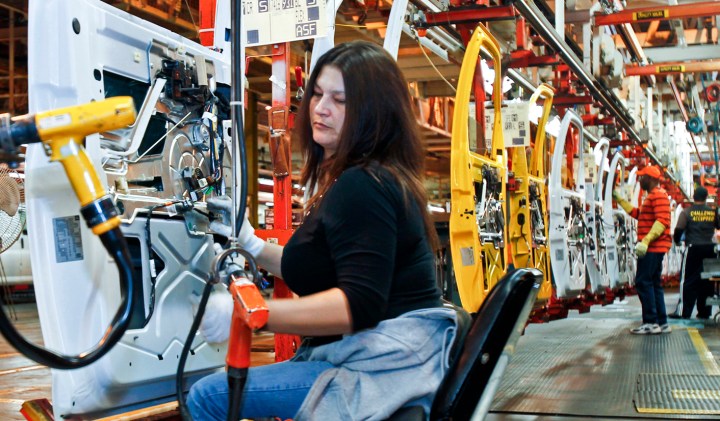Newsdeck
US auto sales miss estimates on soft economy

US auto sales rose a lower-than-expected 9 percent in July as high U.S. unemployment and weak consumer confidence kept would-be buyers on the sidelines. By Deepa Seetharaman and Bernie Woodall.
Wednesday’s figures showed a continuation of the slowdown in sales growth that began in late spring. After a strong start in the first quarter, sales growth has been softer in recent months.
Overall industry sales rose to nearly 1.2 million vehicles in July, according to research firm Autodata Corp. This fell slightly short of Edmunds.com’s estimate of a 10.2 percent jump.
July sales reported by major automakers General Motors Co , Ford Motor Co and Toyota Motor Corp also fell short of several analyst forecasts.
“Perhaps there was an overestimation of consumers’ willingness to spend money,” said TrueCar.com analyst Jesse Toprak.
“It’s the economy. There is no way around it,” said George Magliano, senior economist with IHS Automotive. “In this kind of environment, it’s very difficult for light vehicle sales to get any traction.”
Lack of significant job growth and confusion about government policy on tax cuts and spending tempered sales in July, Magliano said. In conference calls on Wednesday, executives at GM and Ford said the U.S. job market and consumer confidence remain weak.
The annual U.S. auto sales pace for July came in at 14.1 million vehicles, according to Autodata. But the figure was inflated by the Bureau of Economic Analysis’ move Wednesday to revise seasonal factors used to calculate the July annual sales rate.
The BEA revision added about 200,000 vehicle sales to the annual rate for July, KBB economist Alec Gutierrez wrote in a note. When stripping out those additional vehicles, the sales rate slightly missed KBB’s estimate. On average, analysts had expected the July rate to be 14 million.
BRIGHT SPOT IN ECONOMY LOSES LUSTER
Auto sales have been one of the bright spots in the U.S. economy and car companies are anticipating a second-half sales increase spurred partly by the introduction of a slate of new models.
Since 1976, annual new vehicle sales have hovered around 12 million when the U.S. unemployment rate averaged 8 percent or higher, according to Kelley Blue Book. The jobless rate is now 8.2 percent, suggesting that Americans’ growing need to replace their aging models is driving sales to about 14 million.
Still, this demand “cannot carry industry growth indefinitely,” Gutierrez wrote.
GM and Ford executives pointed to recent encouraging signs in the housing sector, which could spur sales of pickup trucks. Meanwhile Toyota and others said attractive financing for consumers would spur sales as well.
“We think some truck buyers have been reacting to the mixed economic signals of the last few months,” said Kurt McNeil, head of GM’s U.S. sales operations. “But recent reports of consumer confidence, home prices, and personal income were better than expected.”
In July, dealers were able to offer better financing packages and other promotions to shoppers. In August, Toyota will offer zero percent financing on seven of its models. GM will continue two programs started in mid-July for its main Chevrolet brand, which accounts for more than 70 percent of GM’s U.S. sales. One allows owners to return new vehicles within 60 days of purchase, and another is a “no haggle” pricing policy.
Jessica Caldwell, analyst with Edmunds.com, said easier credit and low interest rates will help boost auto sales in August and in the coming months.
MISSED ESTIMATES
Major automakers are increasingly counting on the U.S. auto market to offset weak sales in Europe. Last week, Ford reported a more than $1 billion loss in Europe due to the deepening economic crisis in the region.
On Thursday, GM, the largest U.S. automaker, is expected to report second-quarter results. Its Opel brand in Europe is considered one of GM’s biggest risks.
GM executives said they did not expect a change in marketing strategy after its top marketing executive, Joel Ewanick, was abruptly ousted earlier this week.
GM reported on Wednesday a 6 percent drop in July U.S. sales, while Ford posted a 4 percent drop. The smallest U.S. automaker, Chrysler Group LLC, posted a 13 percent increase.
GM sold 201,237 cars and trucks last month. Ford, the No. 2 U.S. automaker, sold 173,966 cars and trucks. Chrysler sold 126,089 cars and trucks.
Toyota sales were up 26 percent to 164,898 in July. A year ago, Toyota was still grappling with major vehicle shortages stemming from the March earthquake in Japan.
Edmunds had expected GM to report 214,315 vehicle sales and Ford at least 175,791. The firm expected Toyota sales to top 169,000. Chrysler beat Edmunds’ sales forecast but fell short of the Barclays Capital estimate of 129,453 vehicles and the RBC Capital Markets projection of 127,889.
Ford shares ended 1.6 percent lower at $9.04, and GM shares dipped 0.3 percent to close at $19.66 on Wednesday. DM
Photo: A view of employees working at the General Motors assembly plant in Wentzville, Missouri February 7, 2012. REUTERS/Sarah Conar



















 Become an Insider
Become an Insider